Description
application instructions: When applying any type of flux, apply as little flux as possible because the residues can be corrosive, conductive, and sticky. This bottle, however, contains very mild flux that is not corrosive or conductive. It also comes with a brush attached to the cap for easy application. We recommend the use of a flux dispensing bottle with a small needle or a flux pen to help limit the amount of flux that is applied. cleaning: This particular flux is extremely mild, non-corrosive and non-conductive, but leaves a sticky residue that may attract dust over time. If you decide to clean the residues (largely unnecessary), use alcohol, an ESD safe brush, and then a lint-free cloth to actually remove the residues from the board–don’t just move them around with the brush. The residues harden quickly after soldering, so clean shortly after applying solder. product details: 2 Fl Oz of non-activated rosin flux classified as type ROL0 under IPC J-STD-004. This translates to “Rosin based, low activity, no halides added,” which means very mild, and cleaning is unnecessary in most cases. spec sheet. Note: Flux is a hazardous, flammable liquid and requires ground shipping to be chosen during checkout. 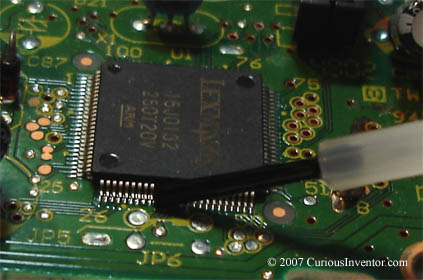 background: Flux is a key component to soldering because it removes oxidation that prevents solder from bonding to metals. Soldering even freshly cleaned metals requires flux because metals oxidize extremely fast under high soldering temperatures. Liquid flux is not necessary for most through-hole work as long as you’re using flux-cored solder wire. However, when soldering surface mount chips additional liquid flux can be essential. For typical through-hole component soldering, heat is applied to the components, and then solder is melted directly on those components. Part of the reason that solder is applied directly to the parts and not the iron is that if applied to the iron first, the flux would likely burn off before being able to clean the joint. Unfortunately, in surface mount soldering, the leads are too small to apply solder to them directly, so it must be applied to the soldering tip first. To ensure that active flux is available when the joint is being made, it’s necessary to apply additional liquid flux directly to the joint. The extra flux also reduces the solder’s surface tension which helps it wick into the small connection areas. Flux also acts as a blanket that helps to spread heat out and prevent additional oxidation from occurring before solder reaches the joint. The main trade-off with flux is its activity level. Higher activity means it will help solder cling to metals faster, and also be able to handle heavier oxidation and much more stubborn oxidation (stainless steel, aluminum). The downside to higher activity is that residues left over can be corrosive and destroy components, be conductive themselves, or provide an environment that allows conductive tentacle-like “dendrites” to grow. Because of this, use the mildest flux that does the job, and if a more active flux is needed, clean thoroughly. Organic and water-soluble fluxes should usually be avoided and cleaned thoroughly when used. Avoid just about all use of flux on stranded wire because the strands can wick the flux under the insulation where it can’t be cleaned. Never use anything from the plumbing isle in your hardware store. lead-free: Lead-free soldering can require higher temperatures that burn off the flux before it can clean the joint. Depending on your iron temperature (if you’re soldering above 750 deg. F you probably shouldn’t be), a flux designed to activate under higher lead-free temperatures may be necessary. other materials: This flux will not be strong enough to solder to stainless steel or aluminum. See our soldering guide for more information on flux.
background: Flux is a key component to soldering because it removes oxidation that prevents solder from bonding to metals. Soldering even freshly cleaned metals requires flux because metals oxidize extremely fast under high soldering temperatures. Liquid flux is not necessary for most through-hole work as long as you’re using flux-cored solder wire. However, when soldering surface mount chips additional liquid flux can be essential. For typical through-hole component soldering, heat is applied to the components, and then solder is melted directly on those components. Part of the reason that solder is applied directly to the parts and not the iron is that if applied to the iron first, the flux would likely burn off before being able to clean the joint. Unfortunately, in surface mount soldering, the leads are too small to apply solder to them directly, so it must be applied to the soldering tip first. To ensure that active flux is available when the joint is being made, it’s necessary to apply additional liquid flux directly to the joint. The extra flux also reduces the solder’s surface tension which helps it wick into the small connection areas. Flux also acts as a blanket that helps to spread heat out and prevent additional oxidation from occurring before solder reaches the joint. The main trade-off with flux is its activity level. Higher activity means it will help solder cling to metals faster, and also be able to handle heavier oxidation and much more stubborn oxidation (stainless steel, aluminum). The downside to higher activity is that residues left over can be corrosive and destroy components, be conductive themselves, or provide an environment that allows conductive tentacle-like “dendrites” to grow. Because of this, use the mildest flux that does the job, and if a more active flux is needed, clean thoroughly. Organic and water-soluble fluxes should usually be avoided and cleaned thoroughly when used. Avoid just about all use of flux on stranded wire because the strands can wick the flux under the insulation where it can’t be cleaned. Never use anything from the plumbing isle in your hardware store. lead-free: Lead-free soldering can require higher temperatures that burn off the flux before it can clean the joint. Depending on your iron temperature (if you’re soldering above 750 deg. F you probably shouldn’t be), a flux designed to activate under higher lead-free temperatures may be necessary. other materials: This flux will not be strong enough to solder to stainless steel or aluminum. See our soldering guide for more information on flux.

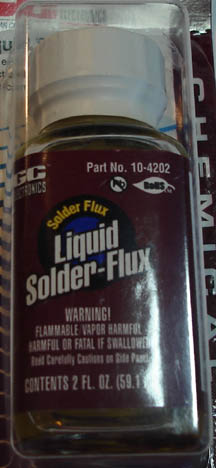
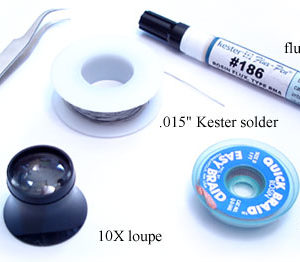
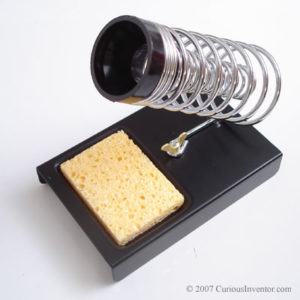
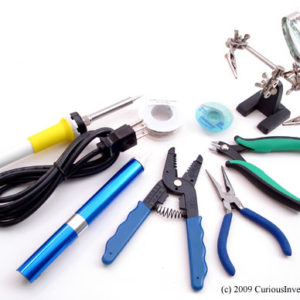
Reviews
There are no reviews yet.